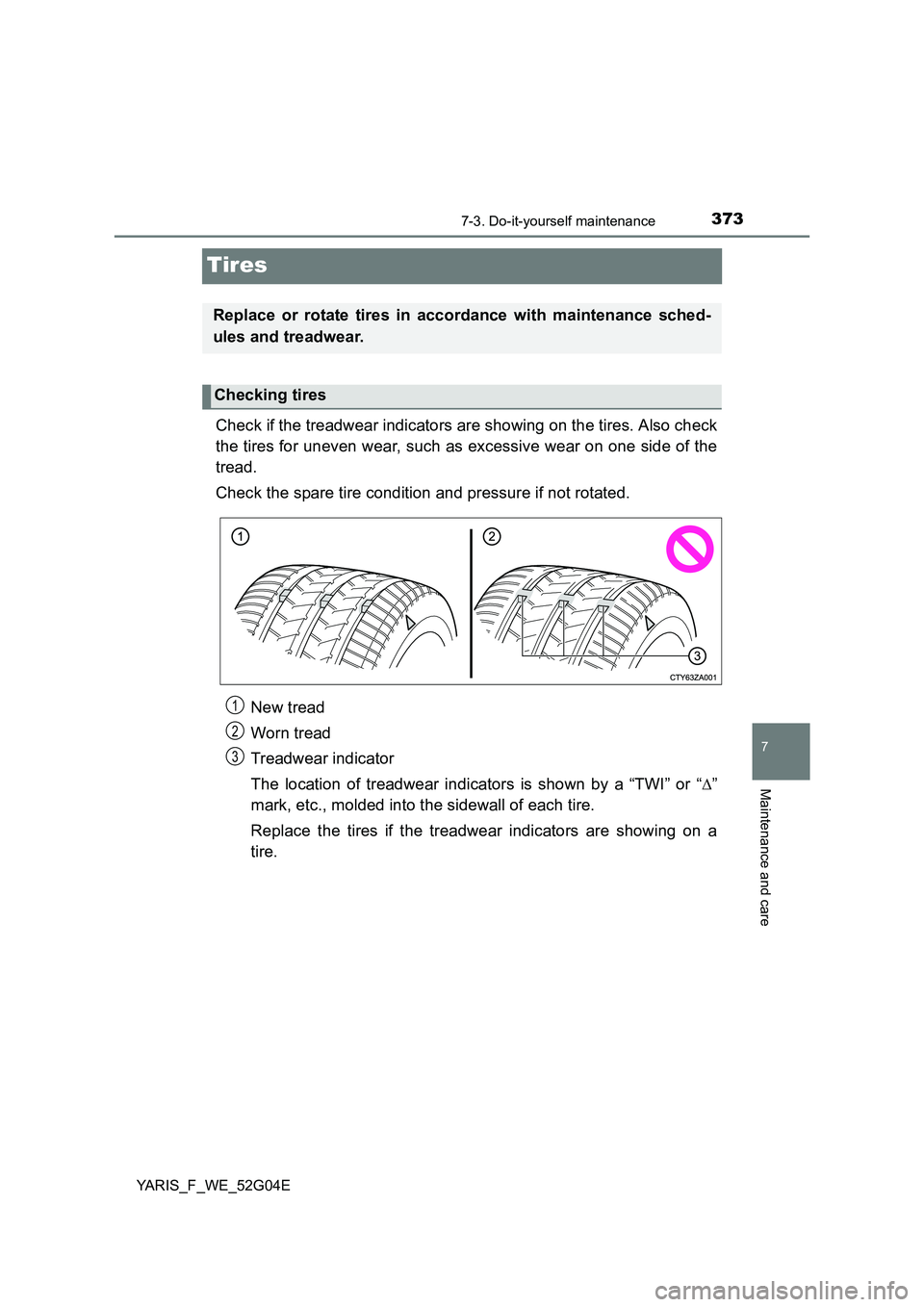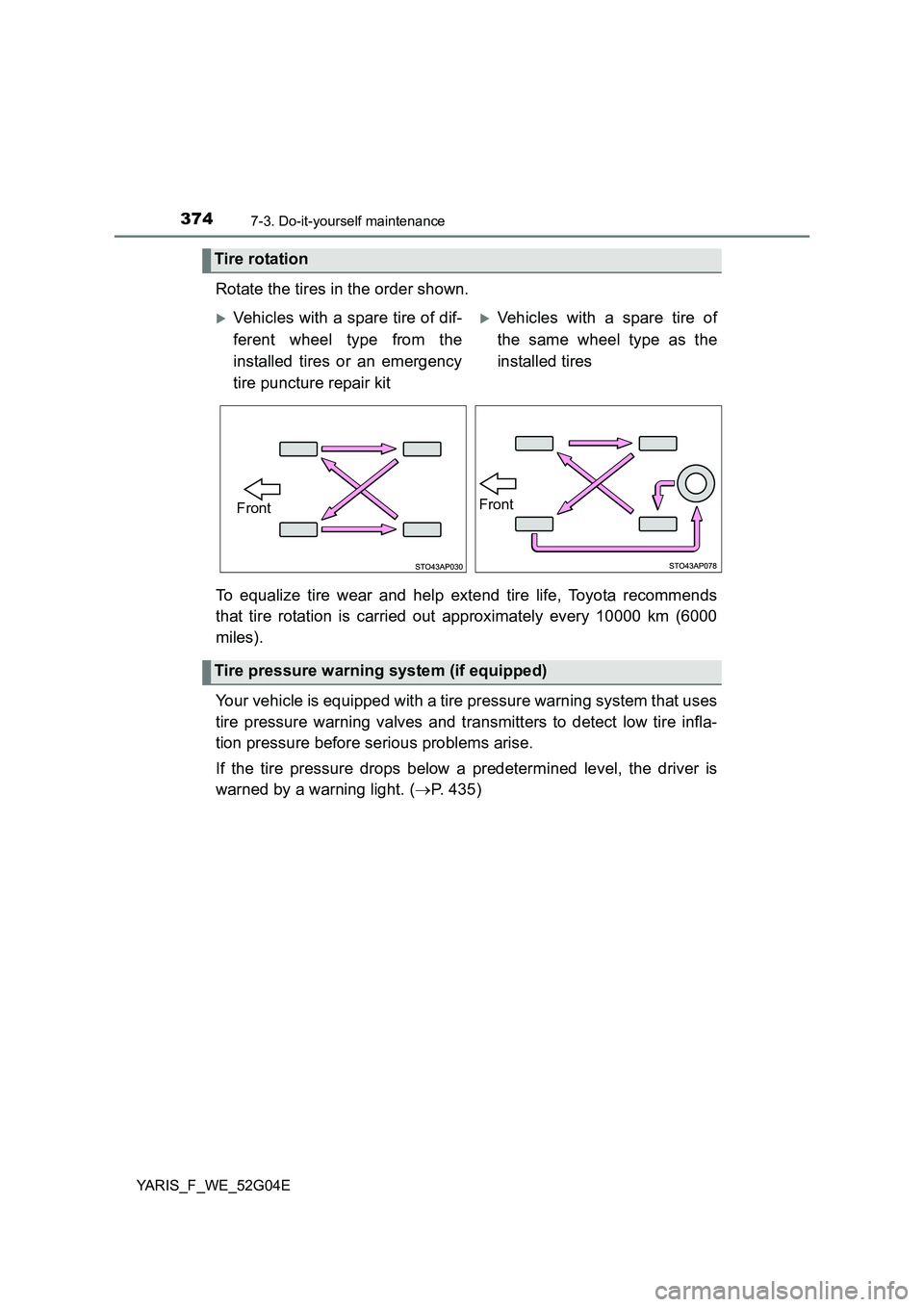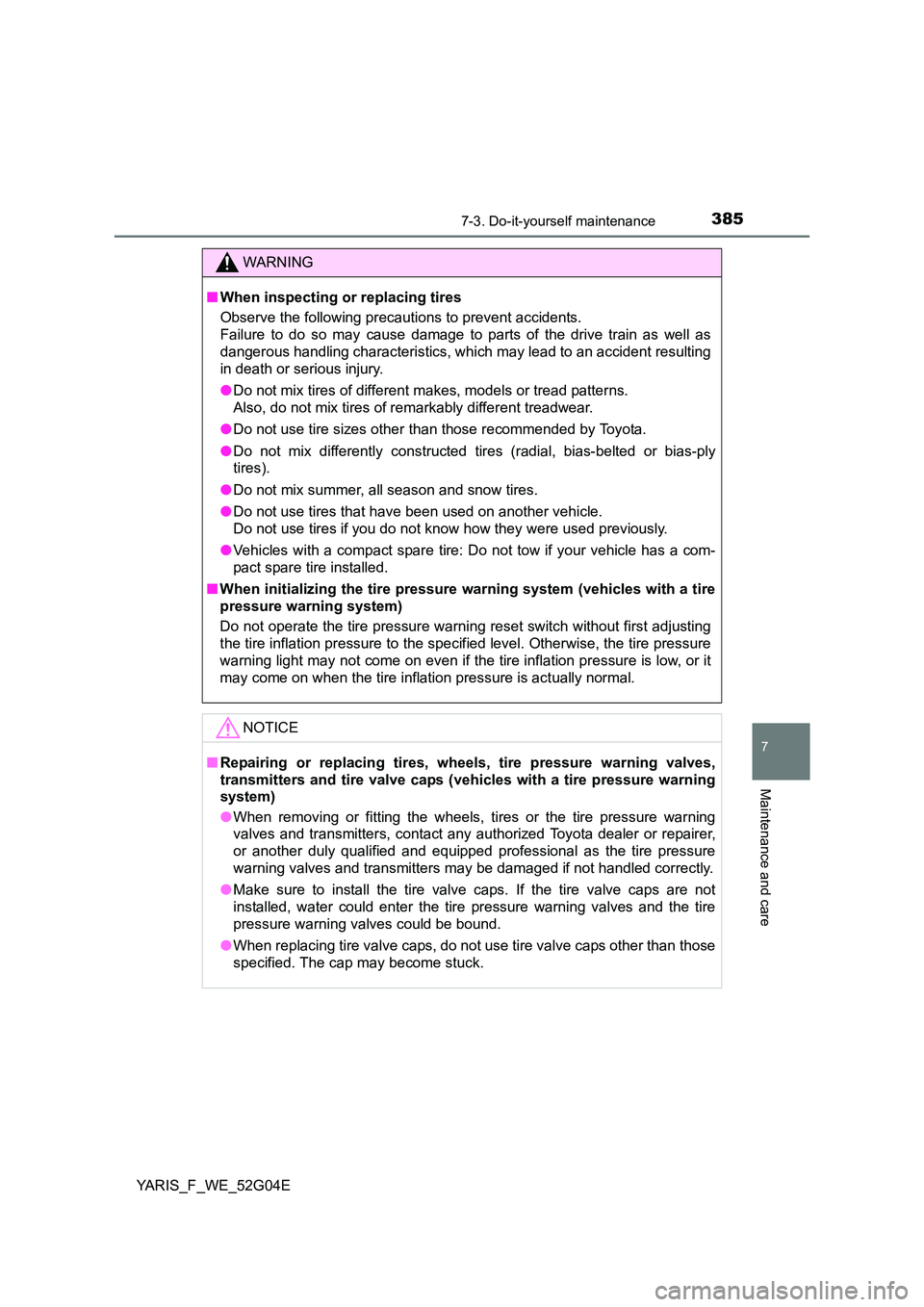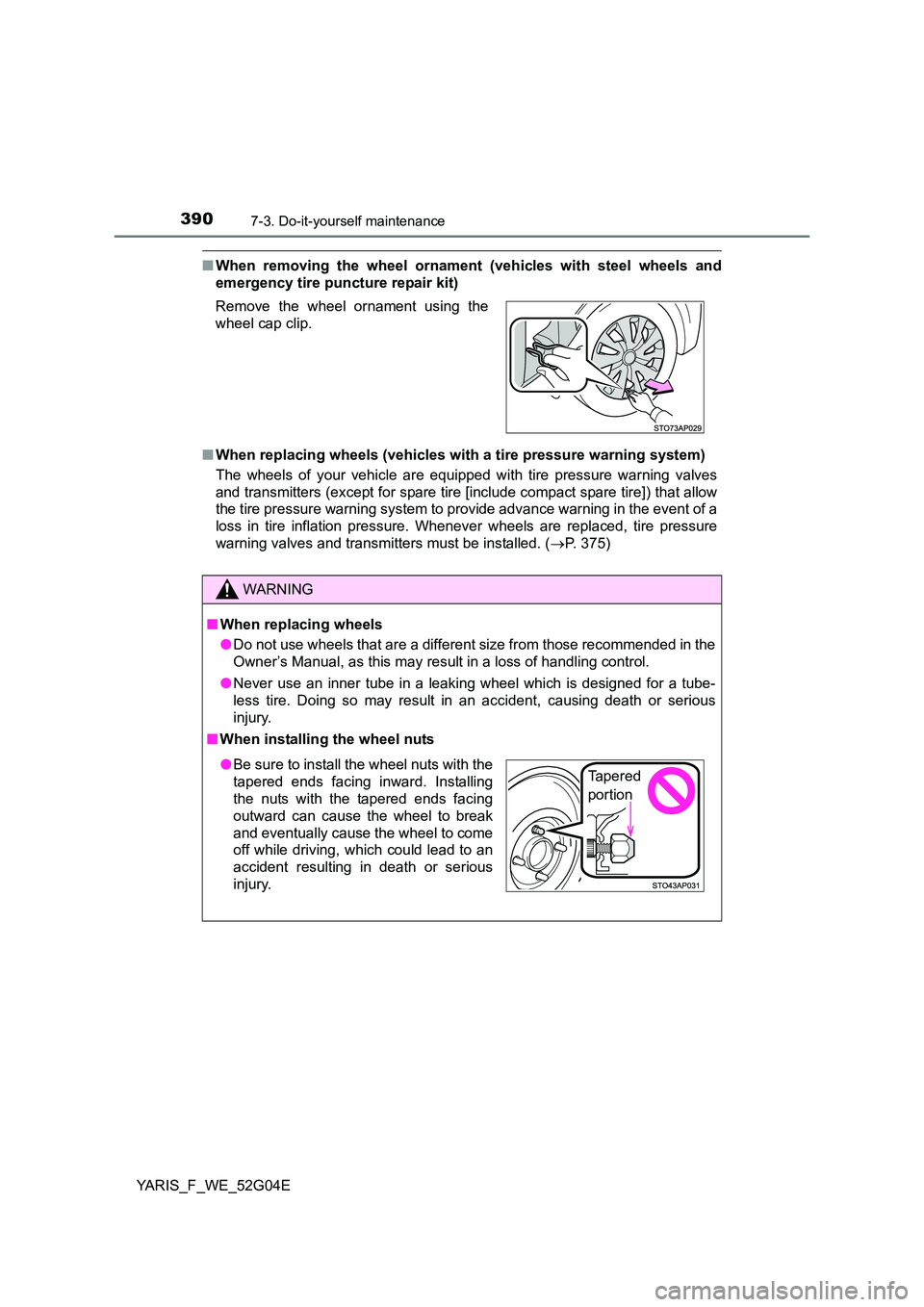2015 TOYOTA YARIS HATCHBACK spare tire
[x] Cancel search: spare tirePage 5 of 540

5
1
7
8
6
5
4
3
2
9
YARIS_F_WE_52G04E
8-1. Essential information
Emergency flashers ...........420
If your vehicle has to
be stopped in
an emergency ..................421
8-2. Steps to take in
an emergency
If your vehicle needs to
be towed ..........................423
If you think something is
wrong ...............................429
Fuel pump shut off system
(gasoline engine only) .....430
If a warning light turns on
or a warning buzzer
sounds .............................431
If you have a flat tire
(vehicles with
a spare tire) .....................445
If you have a flat tire
(vehicles with
an emergency tire
puncture repair kit)...........460
If the engine will not start ...475
If the shift lever cannot
be shifted from P (vehicles
with a Multidrive)..............477
If the electronic key does
not operate properly
(vehicles with a smart
entry & start system)........478
If the vehicle battery is
discharged .......................480
If your vehicle overheats ....485
If you run out of fuel and
the engine stalls
(diesel engine only) ......... 489
If the vehicle becomes
stuck................................ 491
9-1. Specifications
Maintenance data
(fuel, oil level, etc.) .......... 494
Fuel information ................ 513
9-2. Customization
Customizable features ...... 515
9-3. Items to initialize
Items to initialize................ 519
What to do if...
(Troubleshooting) .................... 522
Alphabetical index...................... 526
8When trouble arises
9Vehicle specifications
Index
Page 183 of 540

1834-1. Before driving
4
Driving
YARIS_F_WE_52G04E
■If the engine overheats
Towing a loaded trailer up a long, steep incline in temperatures
exceeding 30 C (85F) may result in the engine overheating. If the
high engine coolant temperature warning light flashes or comes on,
turn the air conditioning off immediately, leave the road and stop the
vehicle in a safe place. ( P. 485)
■When parking the vehicle
Always place wheel chocks under the wheels of both the vehicle
and trailer. Firmly set the parking brake and shift the shift lever to P
for Multidrives or 1 or R for manual transmissions.
WARNING
Follow all the instructions described in this section. Failure to do so could
cause an accident resulting in death or serious injury.
■ Trailer towing precautions
When towing, make sure that none of the weight limits are exceeded.
( P. 176)
■ Vehicle speed in towing
Observe the legal maximum speeds for trailer towing.
■ Before descending hills or long declines
Reduce speed and downshift. However, never downshift suddenly while
descending steep or long downhill grades.
■ Operation of the brake pedal
Do not hold the brake pedal depressed often or for long periods of time.
Doing so may result in the brake overheating or reduce braking effects.
■ To avoid accident or injury
● Vehicles with a cruise control: Do not use cruise control when you are tow-
ing.
● Vehicles with a compact spare tire: Do not tow a trailer when the compact
spare tire is installed on your vehicle.
● Vehicles with an emergency tire puncture repair kit: Do not tow a trailer
when the tire installed is repaired with the emergency tire puncture repair
kit.
Page 240 of 540

2404-5. Toyota Safety Sense
YARIS_F_WE_52G04E
WARNING
■Before using the LDA system
Do not rely solely on the LDA system. The LDA system does not drive the
vehicle automatically, nor does it reduce the amount of care you need to
take. As such, the driver must always assume full responsibility for under-
standing his/her surroundings, for operat ing the steering wheel to correct
the driving line, and for driving safely.
Inappropriate or negligent driving could lead to an accident.
■ To avoid operating the LDA by mistake
Switch the LDA system off using the LDA switch when not in use.
■ Situations unsuitable for LDA system
Do not use the LDA system in any of the following situations.
Otherwise, the system may not function correctly and could result in an
accident.
● When driving with tire chains, a spare tire, or similar equipment
● When there are objects or structures along the roadside that might be mis-
interpreted as lane markers (such as guardrails, a curb, reflector posts,
etc.)
● When driving on snowy roads
● When pavement lane markers are difficult to see due to rain, snow, fog,
sand, dirt, etc.
● When there are visible lines on the pavement from road repairs, or if the
remains of old lane markers are still visible on the road
● When driving on a road with lane closures due to maintenance, or when
driving in a temporary lane
NOTICE
■ To prevent damage to or incorrect operation of the LDA system
● Do not modify the headlights or attach stickers to the surface of the lights.
● Do not modify the suspension. If your suspension needs repairs, contact
any authorized Toyota dealer or repairer, or another duly qualified and
equipped professional.
● Do not install or place anything on the hood or the grille. Also, do not install
a grille guard (bull bars, kangaroo bar etc.).
Page 373 of 540

3737-3. Do-it-yourself maintenance
7
Maintenance and care
YARIS_F_WE_52G04E
Tires
Check if the treadwear indicators are showing on the tires. Also check
the tires for uneven wear, such as excessive wear on one side of the
tread.
Check the spare tire condition and pressure if not rotated.
New tread
Worn tread
Treadwear indicator
The location of treadwear indicators is shown by a “TWI” or “ ”
mark, etc., molded into the sidewall of each tire.
Replace the tires if the treadwear indicators are showing on a
tire.
Replace or rotate tires in accordance with maintenance sched-
ules and treadwear.
Checking tires
1
2
3
Page 374 of 540

3747-3. Do-it-yourself maintenance
YARIS_F_WE_52G04E
Rotate the tires in the order shown.
To equalize tire wear and help extend tire life, Toyota recommends
that tire rotation is carried out approximately every 10000 km (6000
miles).
Your vehicle is equipped with a tire pressure warning system that uses
tire pressure warning valves and transmitters to detect low tire infla-
tion pressure before serious problems arise.
If the tire pressure drops below a predetermined level, the driver is
warned by a warning light. ( P. 435)
Tire rotation
Vehicles with a spare tire of dif-
ferent wheel type from the
installed tires or an emergency
tire puncture repair kit
Vehicles with a spare tire of
the same wheel type as the
installed tires
FrontFront
Tire pressure warning system (if equipped)
Page 385 of 540

3857-3. Do-it-yourself maintenance
7
Maintenance and care
YARIS_F_WE_52G04E
WARNING
■When inspecting or replacing tires
Observe the following precautions to prevent accidents.
Failure to do so may cause damage to parts of the drive train as well as
dangerous handling characteristics, which may lead to an accident resulting
in death or serious injury.
● Do not mix tires of different makes, models or tread patterns.
Also, do not mix tires of remarkably different treadwear.
● Do not use tire sizes other than those recommended by Toyota.
● Do not mix differently constructed tires (radial, bias-belted or bias-ply
tires).
● Do not mix summer, all season and snow tires.
● Do not use tires that have been used on another vehicle.
Do not use tires if you do not know how they were used previously.
● Vehicles with a compact spare tire: Do not tow if your vehicle has a com-
pact spare tire installed.
■ When initializing the tire pressure warning system (vehicles with a tire
pressure warning system)
Do not operate the tire pressure warning reset switch without first adjusting
the tire inflation pressure to the specified level. Otherwise, the tire pressure
warning light may not come on even if the tire inflation pressure is low, or it
may come on when the tire inflation pressure is actually normal.
NOTICE
■ Repairing or replacing tires, wheels, tire pressure warning valves,
transmitters and tire valve caps (vehicles with a tire pressure warning
system)
● When removing or fitting the wheels, tires or the tire pressure warning
valves and transmitters, contact any authorized Toyota dealer or repairer,
or another duly qualified and equipped professional as the tire pressure
warning valves and transmitters may be damaged if not handled correctly.
● Make sure to install the tire valve caps. If the tire valve caps are not
installed, water could enter the tire pressure warning valves and the tire
pressure warning valves could be bound.
● When replacing tire valve caps, do not use tire valve caps other than those
specified. The cap may become stuck.
Page 390 of 540

3907-3. Do-it-yourself maintenance
YARIS_F_WE_52G04E
■When removing the wheel ornament (vehicles with steel wheels and
emergency tire puncture repair kit)
■ When replacing wheels (vehicles with a tire pressure warning system)
The wheels of your vehicle are equipped with tire pressure warning valves
and transmitters (except for spare tire [inc lude compact spare tire]) that allow
the tire pressure warning system to provide advance warning in the event of a
loss in tire inflation pressure. Whenever wheels are replaced, tire pressure
warning valves and transmitters must be installed. ( P. 375)
Remove the wheel ornament using the
wheel cap clip.
WARNING
■ When replacing wheels
● Do not use wheels that are a different size from those recommended in the
Owner’s Manual, as this may result in a loss of handling control.
● Never use an inner tube in a leaking wheel which is designed for a tube-
less tire. Doing so may result in an accident, causing death or serious
injury.
■ When installing the wheel nuts
●Be sure to install the wheel nuts with the
tapered ends facing inward. Installing
the nuts with the tapered ends facing
outward can cause the wheel to break
and eventually cause the wheel to come
off while driving, which could lead to an
accident resulting in death or serious
injury.
Tapered
portion
Page 419 of 540

419
8When trouble arises
YARIS_F_WE_52G04E
8-1. Essential information
Emergency flashers ........... 420
If your vehicle has to
be stopped in
an emergency .................. 421
8-2. Steps to take in
an emergency
If your vehicle needs to
be towed .......................... 423
If you think something is
wrong ............................... 429
Fuel pump shut off system
(gasoline engine only) ..... 430
If a warning light turns on
or a warning buzzer
sounds ............................. 431
If you have a flat tire
(vehicles with
a spare tire) ..................... 445
If you have a flat tire
(vehicles with
an emergency tire
puncture repair kit)........... 460
If the engine will not start ... 475
If the shift lever cannot be
shifted from P (vehicles
with a Multidrive).............. 477
If the electronic key does
not operate properly
(vehicles with a smart
entry & start system)........ 478
If the vehicle battery is
discharged ....................... 480
If your vehicle overheats .... 485
If you run out of fuel and
the engine stalls
(diesel engine only) ......... 489
If the vehicle becomes
stuck ................................ 491